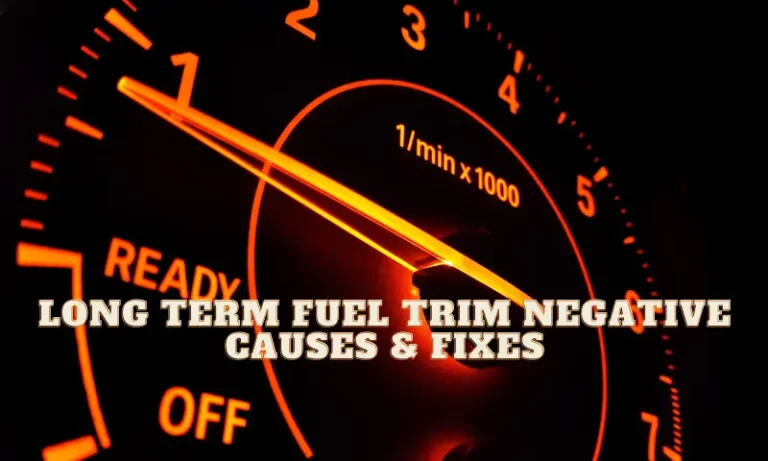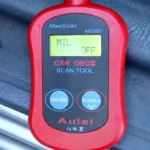Long-term fuel trims relate to the air-fuel ratio and their interaction. The ECM relies on sensors to balance the air-to-fuel ratio in engine combustion.
These sensors include the oxygen sensor, mass airflow sensor (MAF), and Upstream air/fuel ratio.
Simply put, long-term fuel trims are measurements collected from the sensors in response to the adjustments made by the ECM.
Where there are any issues with components such as sensors, leaking intake manifold gasket, clogged air filter, and others, it may affect the air-fuel ratio.
What is long term Fuel trim negative?
Long-Term Fuel Trim Negative (LTFT) relates to problems with the fuel and air mixture entering the engine during combustion.
First, the ECM uses the fuel trim to solve or compensate for all the issues concerning the air-fuel ratios.
It relies on sensors to provide valuable data, which it uses to regulate the engine’s air-to-fuel ratio.
Where your vehicle shows a negative LTFT, it implies one of the adjustments made by the ECM is causing the engine to produce less power compared to the engine’s capability.
Three significant sensors could be traced to the fuel trim. They include the mass air flow sensor (MAF), oxygen sensor (O2), and the upstream air/fuel ratio sensor (A/F).
A physical inspection of the sensors is a first start to resolve this issue.
Symptoms of long term Fuel trim negative
A negative LTFT comes with many serious issues that could cause engine failure. Some of these symptoms include the following.
1. Less power
One of the most common symptoms of a negative LTFT is your engine losing power. When your engine has a negative LTFT, it runs lean or rich. It depends on the ECM’s adjustment to the air-fuel ratio or the cause.
Whether your engine runs rich or lean, it will lose power. Your engine needs the right amount of fuel and air. If one of each is too much, it could harm your engine.
2. Increase fuel consumption
Having a negative LTFT may mean that your engine is running rich. It means that more fuel is going into the engine than usual.
When this happens, you will notice that your engine consumes more fuel.
If your engine runs lean, you might think that your engine will consume little fuel. It could be because you feel less fuel is going to the engine.
It is only sometimes the case. You must understand that the burning condition is not optimal and will significantly reduce fuel economy.
3. Engine stalling
At a point, you will notice that your engine will begin to stall. Sometimes your engine will lose so much power that it would, at intervals, almost turn off. The negative LTFT issue has drastically reduced the fuel or air ratio.
When the air or fuel is too low, the engine can not create power function properly, so it struggles to work.
4. Check the engine light
When your engine is not working right, the ECM knows, thanks to various sensors, and then triggers the check engine light.
All the sensors link back to the ECM, including the upstream air/fuel ratio sensor (A/F) and airflow sensor (MAF). Sensors like this give the ECM data on the air/fuel mixture.
5. Car is not starting
Once your engine cannot create enough power due to extremely low fuel or air, it will not start. At this point, you need to stop attempting to start the vehicle and have it fixed immediately.
Causes of long term Fuel trim negative
Many factors could cause negative long-term fuel trim, including the following.
- Oxygen sensor failure
- Mass airflow sensor failure
- Failing fuel system
- Issues with the ECM
- Damages and leaks
Fixes for long term Fuel trim negative
To fix your long-term fuel trim negative issue properly, you need first to diagnose the issue.
Many factors could cause the problem; once you can find the cause, you can fix it quickly.
Below are ways you can fix a negative long-term fuel trim.
1. Oxygen sensor fix
The oxygen sensor measures the oxygen level in the exhaust gasses. Once they are bad, it will affect the air-fuel mixture.
To solve this, you will first have to locate the oxygen sensor. You can find it on the exhaust manifold close to the catalytic converter. Once you find it, examine the sensor and the wires for any damages before replacing them
2. Mass airflow sensor failure fix
The mass air flow sensor measures the air that goes into the engine. The sensor will send air readings to the ECM, which it uses to adjust the air-fuel ratio.
Once the sensor is bad, it gives out wrong readings or does send data at all, which could drastically affect the Air-fuel ratio.
To address this issue, locate the MAS between the air filter and the engine’s intake. Inspect the wires and the sensor; if they are damaged, make adequate replacements.
3. Failing fuel system
The fuel system consists of various parts, which include the pump, filter, and injector. Once they are bad, you will need to replace them immediately. Due to the system’s complexity, you might need professional help for diagnosis and fixing.
4. Issues with the ECM
The ECM is responsible for ensuring the engine is in good condition. It does this thanks to the sensors feeding it data about the working condition of the engine and other components.
When the ECM is damaged, it could be a software issue requiring reprogramming. Sometimes, the ECM cannot be repaired and needs to be replaced.
5. Damages and leaks
Fuel leaks could cause your negative LTFT issues. You can quickly notice a leak by looking beneath your car; you will see fuel leaks on the ground. You will also smell fuel gas all around the vehicle.
Solving this problem depends on where the leak is coming from. It could be a fuel tank leak, lines, a damaged pump, etc. Once you find where the leak is coming from, you need to make appropriate repairs.
Conclusion
You can fix the issues now that you understand what could cause a Long Term Fuel Trim Negative.
You must know that some of the fixes might require professional help.
Some negative LTFT fixes might require significant mechanical knowledge and welding skills. For instance, if you leak the fuel tank, you might need to weld or change the tank completely.




